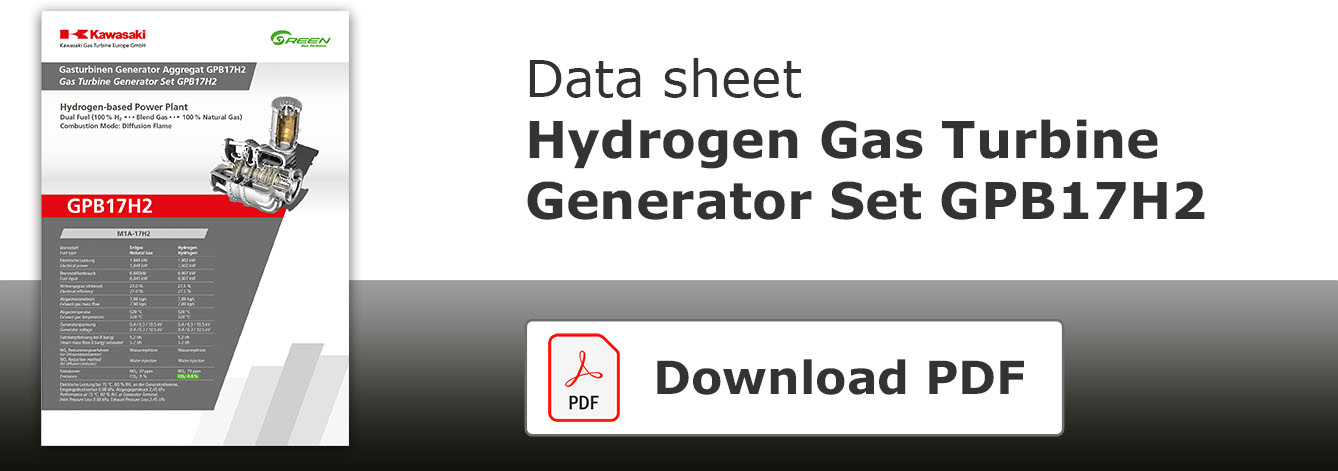Enhancement of Fuel Flexibility of Industrial Gas Turbines by Development of Innovative Hydrogen Combustion Systems
H2 Micro Mix combustion chamber
Within the last decade the global demand for renewable energy has increased rapidly, which leads to new challenges for conventional power generation systems. For nuclear and coal power plants it will be very difficult to be part of the power generation in the future, especially in Europe. In case of overcoming the new challenges, the gas turbine technology has realistic chances to solidify and expand its role in the future power generation.
In the past “efficiency” was the only key driver for gas turbine developments. Nowadays, flexible power generation systems and energy storage systems become increasingly more important to fulfill the requirements of the renewable energy market. Thus, the gas turbine in the future must offer more operational flexibilities, such as a higher number of starts, lower emissions at partial load, hot start capability, short start time, low maintenance and flexible in fuel to meet the requirements of the renewable energy market.
To enhance fuel flexibility, hydrogen has great potential as a renewable and sustainable energy source derived from wind or solar power and gasification of biomass and therefore substituting the limited resources of fossil fuels. It represents a possible alternative gas turbine fuel within future low emission power generation, paired with the use of renewable energy sources for its production.
Due to the large differences in the physical properties of hydrogen compared to other fuels such as natural gas, the combustion of hydrogen gases is a very challenging task, especially for the Dry Low Emission (DLE) combustion.
Nevertheless, Kawasaki Heavy Industries overcame these challenges and developed 3 different H2-combustion systems, which are illustrated in Figure 1.
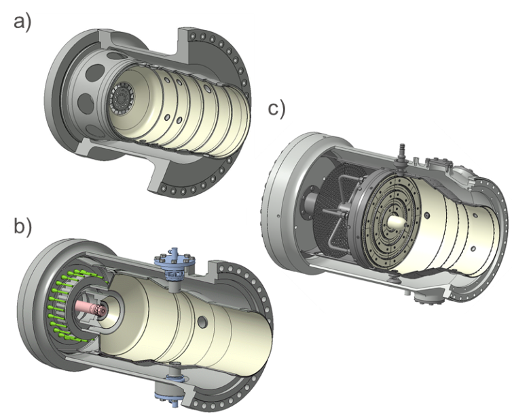
Figure 1: Different hydrogen combustion systems:
a) Diffusion flame
b) Supplemental burner
c) Micro-Mix burner (MMX)
The diffusion flame combustor in Figure 1a can operate with 100% hydrogen and 100% natural gas and also with mixtures of both. Water injection is used to achieve low emissions.
The first gas turbine with this diffusion flame combustor has been used in the project “Development of smart community technology by Utilization of Hydrogen CGS (Co-Generation System)”. This project is subsidized by NEDO (New Energy and Industrial Technology Development Organization). The successful commissioning took place on the 19th and 20th of April 2018 in a demonstration plant in Kobe, see Figure 2.
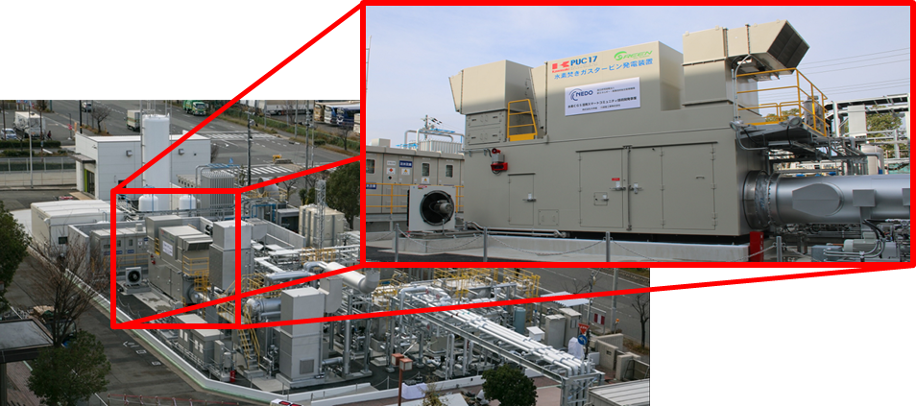
Figure 2: World’s first pure hydrogen and natural gas demonstration plant in Kobe (Japan)
Figure 3 shows the process control interface, during the 100% hydrogen fuel operation mode. The electrical power output is approx. 1.5MW. The amount of measured NOx emission during 100% hydrogen combustion is 50ppm (16% Vol.O2).
In total, three different fuel modes are available at the touch of a button, which leads to very high flexible operation. The first fuel mode “Natural Gas Only” is the conventional operation with natural gas. The second mode “Blend Gas” is the operation with mixtures ratios of natural gas and hydrogen. The mixture ratio can vary from 1% – 99% hydrogen. The third mode “H2 Gas Only” is the innovative pure hydrogen fuel mode, as visualized below.
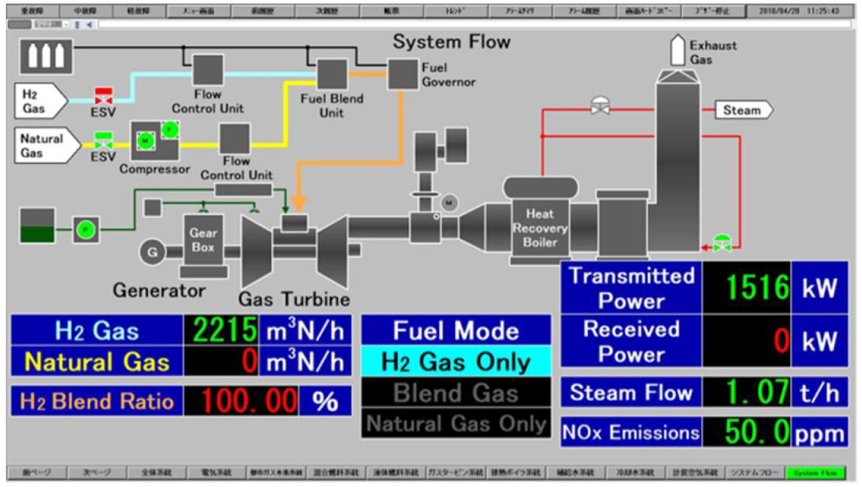
Figure 3: Process controlling interface of Kobe plant
The second development in Figure 1b based on a conventional DLE combustor with hydrogen injection over the supplemental burner up to 60 Vol% hydrogen, which correspond to 30 % of the total thermal input. Basically the DLE combustor of KHI has pilot, main and supplemental burners. Usually natural gas is supplied from the supplemental burners. Within this combustor, it can be switched from natural gas to hydrogen or natural gas and hydrogen mixing gas fuel via the supplemental burner. The NOx emission can be kept below the 25 ppm (O2 – 15 %) guaranteed level. This combustor has also been tested successfully at Akashi Works.
Using hydrogen in conventional DLE combustors increase the NOx emissions values as well as the risk of flashbacks. The established gas turbine combustion systems cannot be directly applied. Thus, the development of DLE H2 combustion technologies is indispensable for pure hydrogen (100 Vol%) combustion.
Therefore, the innovative Micro-Mix DLE combustion chamber (MMX combustor) Figure 1c has been developed by using an interactive optimization cycle including experimental and numerical studies on test burners and full scale combustion chamber investigations. The feasibility is proven in real gas turbine operation, as visualized in Figure 4.
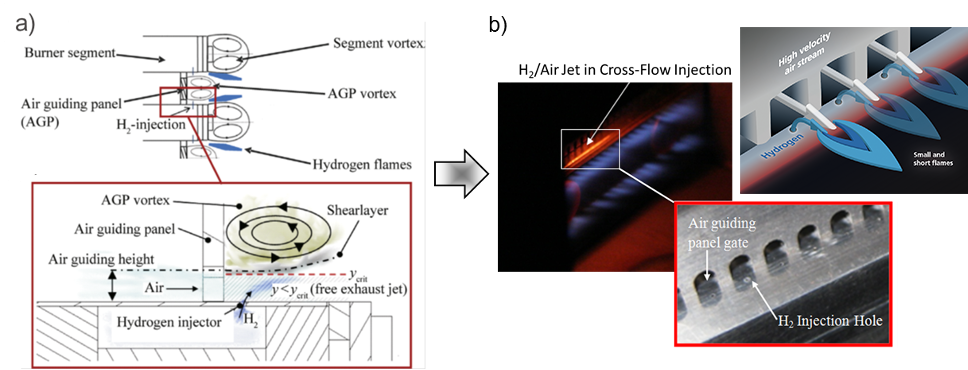
Figure 4:
a) Aerodynamic flame stabilization principle
b) Hydrogen injection depth definition. [10]
Former investigations showed, that the flame anchoring and therewith the NOx formation is mostly dominated by the resulting recirculation zones of the burner geometry [7] and by the momentum flux ratio of the jet in cross-flow [8]. Multiple micro flames instead of large scale flames lower the residence time of the NOx forming reactants and consequently the averaged molar fraction of NOx can be reduced significantly.
The first design started with about 1600 miniaturized flames, with fuel injector diameters of 0.3mm.
To increase the energy density of a Micro-Mix combustor it is required to increase the power per fuel injector. If the power per injector is to be increased, the required fuel flow per injector must also increase. The established fuel velocity in each single injector is to be maintained as a design parameter and in consequence the injector size must increase. However, the micro flames must still established to keep the low NOx characteristics. This was achieved by stepwise increased hole diameter of the H2-injectors from 0.3mm to 0.45mm, 0.55mm up to 1.0 mm.
The multiple micro flames at the test burner are visualized in Figure 4. The H2-injection holes and the air guiding panels are also visible.
The power-increase per injector leads to a reduction of manufacturing complexity, because the number of required injectors could be reduced significantly. Within the development and optimization process the number of holes was reduced from 1600 flames down to 410 flames. Detailed information is presented in [11].
For pure hydrogen under gas turbine operational conditions the low NOx capability of the Micro-Mix principle has already been successfully tested.
Figure 5 shows the prototype combustion chamber and Micro-Mix burner. The Micro-Mix burner with its three ring segments is implemented in a conventional can type combustion chamber. The rings are supplied with H2 from the center which is connected via pipes to each ring segment. Each ring segment can be controlled individually depending on the power load.
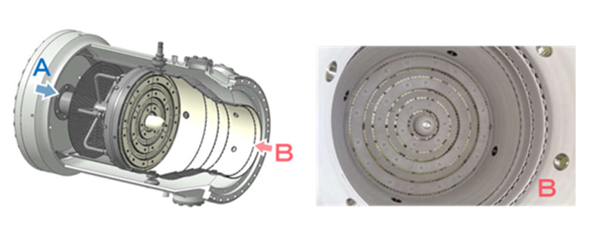
Figure 5: Prototyp des Micro-Mix-Testbrenners
Figure 6 shows the NOx emission (O2 – 5% corrected values) for the test burner at 2 bar condition. Horizontal axis shows the thermal input; load 100 % means full load (design point) and 0 % means idle conditions. Fuel supply staging is possible. From idle to 30 % load conditions, inner 2 hydrogen rings were used and from 30% load to full load conditions, all 3 rings were used. It can be seen, that low NOx values are also achieve at partial load. The NOx values are below 20 ppm over the whole load range.
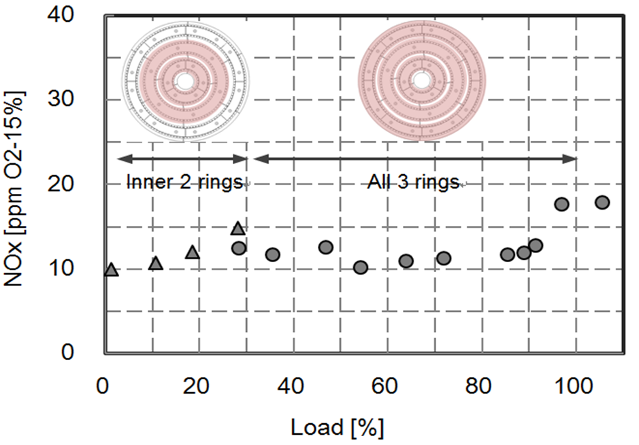
Figure 6: NOx distribution over load for test burner at 2 bar
Conclusion:
Combined with the use of renewable energy sources for its production, hydrogen represents a possible alternative gas turbine fuel within future low emission power generation.
In the Kawasaki hydrogen technology developments, hydrogen gas turbine and hydrogen combustion technologies have been developed.
The commissioning of the world’s first diffusion flame combustor with 100 % hydrogen fueled gas turbine has been carried out successfully in Kobe, Japan.
In addition, the hydrogen fueled Micro-Mix DLE test burner has been tested successfully under atmospheric and pressurized conditions and has proven its dry low NOx ability over a wide operating range. Numerical investigations with different combustion models revealed the ability of the applied numerical approach to simulate the Micro-Mix combustion and to capture the typical Micro-Mix flame anchoring and structure.
The Micro-Mix combustion principle leads due to the miniaturized micro flames to significantly reduced NOx emissions with inherent safety against flashback.
Author:
Dr.-Ing. Nurettin Tekin
KAWASAKI Gas Turbine Europe GmbH
Tel.: +49 (6172) 7363 - 81
E-Mail: n.tekin@kge-gmbh.com
References:
[1] A. Haj Ayed, K. Kusterer, H.H.-W. Funke, J. Keinz, C. Striegan, D. Bohn “Experimental and numerical investigations of the dry-low-NOx hydrogen micro mix combustion chamber of an industrial gas turbine”, Propulsion and Power Research 2015; 4(3):123–131.
[2] Shum, F., Ziemann, J., 1996, “Potential use of hydrogen in air propulsion,” Euro-Québec Hydro-Hydrogen Pilot Project (EQHHPP), European Union, Contract No. 4541-91-11 EL ISP PC, Final Report.
[3] Westenberger A., 2003. “Liquid Hydrogen Fuelled Aircraft – System Analysis, CRYOPLANE”, Final Technical Report No. GRD1-1999-10014, to the European Commission
[4] Moriarty, P., and Honnery, D., 2009, “Hydrogen's role in an uncertain energy future,” International Journal of Hydrogen Energy, 34(1), pp. 31–39.
[5] Dahl, G., and Suttrop, F., 1998, “Engine Control and Low-NOx Combustion for Hydrogen Fuelled Aircraft Gas Turbines,” International Journal of Hydrogen Energy, 23(8), pp. 695-704.
[6] Suttrop, F., Dorneiski R., 1991, “Low NOx-Potential of Hydrogen-Fuelled Gas Turbine Engines,” 1st Int. Conference on Comb. Techn. for Clean Environment.
[7] Funke, H., Börner, S., Keinz, J., Hendrick, P., Recker, E., „Low NOx Hydrogen combustion chamber for industrial gas turbine applications“, 14th International Symposium on Transport Phe-nomena and Dynamics of Rotating Machinery, ISROMAC-14 Honolulu, Hawaii, Feb. 2012
[8] Funke, H. H.-W., Börner, S., Keinz, J., Kusterer, K., Kroniger, D., Kitajima, J., Kazari, M., Horikawa, A., „Numerical and experimental characterization of low NOx Micro Mix combustion principle for industrial hydrogen gas turbine applications“, ASME Turbo Expo 2012, GT2012-69421, Copenhagen, DK, June 2012.
[9] Funke, H. H.-W., Boerner, S., Robinson, A., Hendrick, P., and Recker, E., 2010, “Low NOx H2 combustion for industrial gas turbines of various power ranges,” ETN-2010-42, Proc. of the 5th International Conference the Future of Gas Turbine Technology, Brussels, Belgium.
[10] H. H.-W. Funkea, J. Dickhoff, J. Keinz, A. Haj Ayed, A. Parente, P. Hendrick “Experimental and Numerical Study of the Micro Mix Combustion Principle Applied for Hydrogen and Hydrogen-Rich Syngas as Fuel with Increased Energy Density for Industrial Gas Turbine Applications”, The 6th International Conference on Applied Energy – ICAE 2014-863.
[11] Funke, H. H.-W., Keinz, J., Börner, S., Kusterer, K., Haj Ayed, A., Tekin, N., Kazari, M., Kitajima, J., Horikawa, A., K. Okada, „Experimental and Numerical Characterization of the Dry Low NOx Micro Mix Hydrogen Combustion Principle at Increased Energy Density For Industrial Hydrogen Gas Turbine Applications“, ASME Turbo Expo 2013, GT2013-94771, San Antonio/Texas, USA, June 2013.


